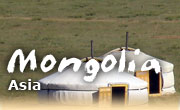
|
Horseback riding tours
Rides in
Mongolia
Intro to Mongolia
![]() Gobi Steppe Gobi Steppe![]() Khan Khentii Khan Khentii
Georgia
India
Siberia
|

|
|

|
|
|

Gobi Steppe Ride
Gobi Steppe
Mongolia
This horseback journey across the Mongolian steppe lands is hosted by the Steppe Nomads themselves, the largest remaining pastoralist people on Earth. An experience not available anywhere else on Earth. Steppe habitats once made up 25 percent of the global land area. Today the Pampas, the Puszta, the Prairies and the Ukrainian steppes have largely been developed for agricultural output. Only the Mongolian steppes have survived. The high elevation of Mongolia creates unusually clear air and starry nights the year round. It is an overwhelming visual experience of emptiness and vastness to ride into the great Mongolian void. The silent, treeless steppe, completely devoid of any fences. Stretching away into the distance: no trace of human activity except for the pastoralists themselves and their herds. This ride covers surprisingly contrasting habitat, patchy water sources along the way nurturing wildlife. Wolves may be heard vocalizing at any time in the summer, but usually, they are not seen. We will undertake this horse ride as a "Nomadic Journey", e.g. without vehicle support, in wild terrain.
All our luggage will be loaded onto camel carts; They are Bactrian two-humped camels, well adapted to the winter climate in Mongolia. Even a ger (Mongolian yurt) will be carried to serve as our mobile restaurant.
Truly a once and a life-time experience, complete with traditional camel caravan, hardy Mongolian bred mounts, and knowledgeable and experienced herdsmen sharing their remote and roaming culture with you!
|
Camping Ride with vehicle support
Camping Ride with pack horses
Family Vacation
|
|
Meeting:
|
Ulaanbaatar
|
|
Airport:
|
Chinggis Khaan International Airport (UBN)
|
|
Transfer:
|
Ulaanbaatar
|
|
Riders:
|
Min
2 riders
Max
10 riders
|
|
Trip Brochure (PDF)  Trip Rating
Trip Rating

|
|
|
|
Rates and Dates for 2026
Rates include*:
Accommodations, Most meals, 8 riding days & Transfers
There are other language guides such as Russian, French, German, Italian, Korean etc. available at additional cost
| A | 2026 | 12 day trip | 12d / 11n | $2900 |
�����������������������������������������������������������������������������������������������������������������������������������������������������������������������������������������������������������������������������������������������������������������������������������������������������������������������������������������������������������������������������������������������������������������������������������������������������������������������������������������������������������������������������������������������������������������������������������������������������������������������������������������������������������������������������������������������������������������������������������������������������������������������������������������������������������������������������������������������������������������������������������������������������������������������������������������������������������������������������������������������������������������������������������������������������������������������������������������������������������������������������������������������������������������������������������������������������������������������������������������������������������������������������������������������������������������������������������������������������������������������������������������������������������������������������������������������������������������������������������������������������������������������������������������������������������������������������������������������������������������������������������������������������������������������������������������������������������������������������������������������������������������������������������������������������������������������������������������������������������������������������������������������������������������������������������������������������������������������������������������������������������������������������������������������������������������������������������������������������������������������������������������������������������������������������������������������������������������������������������������������������������������������������������������������������������������������������������������������������������������������������������������������������������������������������������������������������������������������������������������������������������������������������������������������������������������������������������������������������������������������������������������������������������������������������������������������������������������������������������������������������������������������������������������������������������������������������������������������������������������������������������������������������������������������������������������������������������������������������������������������������������������������������������������������������������������������������������������������������������������������������������������������������������������������������������������������������������������������������������������������������������������������������������������������������������������������������������������������������������������������������������������������������������������������������������������������������������������������������������������������������������������������������������������������������������������������������������������������������������������������������������������������������������������������������������������������������������������������������������������������������������������������������������������������������������������������������������������������������������������������������������������������������������������������������������������������������������������������������������������������������������������������������������������������������������������������������������������������������������������������������������������������������������������������������������������������������������������������������������������������������������������������������������������������������������������������������������������������������������������������������������������������������������������������������������������������������������������������������������������������������������������������������������������������������������������������������������������������������������������������������������������������������������������������������������������������������������������������������������������������������������������������������������������������������������������������������������������������������������������������������������������������������������������������������������������������������������������������������������������������������������������������������������������������������������������������������������������������������������������������������������������������������������������������������������������������������������������������������������������������������������������������������������������������������������������������������������������������������������������������������������������������������������������������������������������������������������������������������������������������������������������������������������������������������������������������������������������������������������������������������������������������������������������������������������������������������������������������������������������������������������������������������������������������������������������������������������������������������������������������������������������������������������������������������������������������������������������������������������������������������������������������������������������������������������������������������������������������������������������������������������������������������������������������������������������������������������������������������������������������������������������������������������������������������������������������������������������������������������������������������������������������������������������������������������������������������������������������������������������������������������������������������������������������������������������������������������������������������������������������������������������������������������������������������������������������������������������������������������������������������������������������������������������������������������������������������������������������������������������������������������������������������������������������������������������������������������������������������������������������������������������������������������������������������������������������������������������������������������������������������������������������������������������������������������������������������������������������������������������������������������������������������������������������������������������������������������������������������������������������������������������������������������������������������������������������������������������������������������������������������������������������������������������������������������������������������������������������������������������������������������������������������������������������������������������������������������������������������������������������������������������������������������������������������������������������������������������������������������������������������������������������������������������������������������������������������������������������������������������������������������������������������������������������������������������������������������������������������������������������������������������������������������������������������������������������������������������������������������������������������������������������������������������������������������������������������������������������������������������������������������������������������������������������������������������������������������������������������������������������������������������������������������������������������������������������������������������������������������������������������������������������������������������������������������������������������������������������������������������������������������������������������������������������������������������������������������������������������������������������������������������������������������������������������������������������������������������������������������������������������������������������������������������������������������������������������������������������������������������������������������������������������������������������������������������������������������������������������������������������������������������������������������������������������������������������������������������������������������������������������������������������������������������������������������������������������������������������������������������������������������������������������������������������������������������������������������������������������������������������������������������������������������������������������������������������������������������������������������������������������������������������������������������������������������������������������������������������������������������������������������������������������������������������������������������������������������������������������������������������������������������������������������������������������������������������������������������������������������������������������������������������������������������������������������������������������������������������������������������������������������������������������������������������������������������������������������������������������������������������������������������������������������������������������������������������������������������������������������������������������������������������������������������������������������������������������������������������������������������������������������������������������������������������������������������������������������������������������������������������������������������������������������������������������������������������������������������������������������������������������������������������������������������������������������������������������������������������������������������������������������������������������������������������������������������������������������������������������������������������������������������������������������������������������������������������������������������������������������������������������������������������������������������������������������������������������������������������������������������������������������������������������������������������������������������������������������������������������������������������������������������������������������������������������������������������������������������������������������������������������������������������������������������������������������������������������������������������������������������������������������������������������������������������������������������������������������������������������������������������������������������������������������������������������������������������������������������������������������������������������������������������������������������������������������������������������������������������������������������������������������������������������������������������������������������������������������������������������������������������������������������������������������������������������������������������������������������������������������������������������������������������������������������������������������������������������������������������������������������������������������������������������������������������������������������������������������������������������������������������������������������������������������������������������������������������������������������������������������������������������������������������������������������������������������������������������������������������������������������������������������������������������������������������������������������������������������������������������������������������������������������������������������������������������������������������������������������������������������������������������������������������������������������������������������������������������������������������������������������������������������������������������������������������������������������������������������������������������������������������������������������������������������������������������������������������������������������������������������������������������������������������������������������������������������������������������������������������������������������������������������������������������������������������������������������������������������������������������������������������������������������������������������������������������������������������������������������������������������������������������������������������������������������������������������������������������������������������������������������������������������������������������������������������������������������������������������������������������������������������������������������������������������������������������������������������������������������������������������������������������������������������������������������������������������������������������������������������������������������������������������������������������������������������������������������������������������������������������������������������������������������������������������������������������������������������������������������������������������������������������������������������������������������������������������������������������������������������������������������������������������������������������������������������������������������������������������������������������������������������������������������������������������������������������������������������������������������������������������������������������������������������������������������������������������������������������������������������������������������������������������������������������������������������������������������������������������������������������������������������������������������������������������������������������������������������������������������������������������������������������������������������������������������������������������������������������������������������������������������������������������������������������������������������������������������������������������������������
* prices are per person based on double/twin occupancy
Transfer and Other Charges:
|
2026
|
Transfers from/to Ulaanbaatar airport included
|
$0
|
|
2026
|
Single room/ tent/ ger supplement
|
$550
|
|
2026
|
No single supplement if willing to share
|
$0
|
|
2026
|
Private trip supplement (2-4 pax), per trip
This is a "Group Rate"
|
$500
|
|
2026
|
Private trip supplement (5+ pax) - no extra charge
This is a "Group Rate"
|
$0
|
Pick-up/ drop-off for this trip is from Chinggis Khaan International Airport in Ulaanbaatar (UBN). You will be met for your arrival flight on Day 1 of the trip. Check-out from your hotel on the last day: 12:00pm.
Rates do not include:
Gratuities, Airport departure tax, Lunches & Dinners in Ulaanbaatar (except for welcome and farewell dinner), Alcoholic drinks & Health and accident insurance (mandatory)
Bring your own sleeping bag
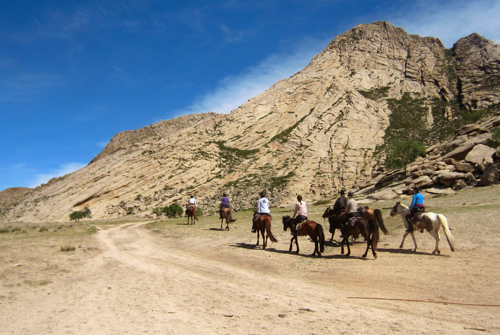 Sample Itinerary - subject to changes
Note: Riding tours may be done in the reverse for operational reasons.
Day 1: Arrival
Sample Itinerary - subject to changes
Note: Riding tours may be done in the reverse for operational reasons.
Day 1: Arrival
Arrive the Mongolian capital and transfer to the hotel. Tour briefing after dinner.
Meals included: Dinner
Overnight at Hotel in Ulaanbaatar
Day 2: To Suman
In the morning, you are picked-up from your hotel. You will visit the Gandan lamasery, possibly in time for the prayers (center for the Buddhist revival in Mongolia). The Mongols follow the Tibetan version of Lamaism, Dalai Lama being the supreme theocratical leader.
We then drive south and enjoy a picnic en route. Our crew here are your hosts, the steppe nomads of the area. They have brought their horses for our use and will accompany us throughout this ride. In the late afternoon we will make a short trial ride.
Meals included: Breakfast, Lunch & Dinner
Overnight in Tipis
Day 3: Gobi grasslands Ride
We go on a full day ride across the Gobi grasslands with a 360° degrees undisturbed landscape view.
Meals included: Breakfast, Lunch & Dinner
Overnight in Tipis
Day 4: Bayan Mountains Ride
Today we break the camp and the yurt/ger we brought along as our restaurant and social area. Provisions and luggage will be loaded on to the support vehicle. While the support vehicle will move straight on to our next destination at the sacred mountains of Zorgol Hairkhan, we will ride a detour easterly across the fantastic grasslands to Bayan Mountain, home to Gobi high altitude fauna like Siberian Ibex (Capra sibirica) and Argali Sheep (Ovis ammon). These animals take shelter in the hills and rocks, and quite possibly, may be seen during this day. Moreover, small herds of gazelle might be seen on the steppe, perhaps some foxes. There are also wolves, but they are almost never spotted. We will pitch camp at Zorgol Hairkhan and remain here for two nights.
Meals included: Breakfast, Lunch & Dinner
Overnight in camp at Zorgol Hairkhan
Day 5: Ikh Zorgol Hairkhan Mountains
The landscape is quite diverse here since we are in the transition zone of the Gobi. There is true steppe, semi-arid steppe, and giant rock formations. For the full day we will explore the Zorgol Hairkhan massif with its vertical rock walls, and ride around and through rock formations, several hundred meters high, a striking feature the middle of the flat steppe.
Meals included: Breakfast, Lunch & Dinner
Overnight in camp at Zorgol Hairkhan
Day 6: To Saikhan
Again, we break camp and the support car starts moving in a straight line to our next destination at Saikhan, skirting Baga Zorgol Hairkhan Uul. Baga means “small”, it is the smaller version of Ikh “big” Zorgol. Here we will probably encounter quite a few nomadic families, as we head for Hariin Nuur (Remote Lake), a steppe lake useful for the steppe nomads. Usually, the lake attracts different species of birds. Our private camp has been set up already at Saikhan.
Meals included: Breakfast, Lunch & Dinner
Overnight in camp at Saikhan
Day 7: To Bumbat
A full-day ride takes us across the steppe to Bumbat, which again is an uninhabited area, featuring some spectacular rock formations. Here it is even more likely to spot Argali Sheep, Cinereous Vultures, Saker Falcons (Falco cherrug) and other wildlife. We will also be able to see some of the petroglyphs, for which Mongolia is so famous.
Meals included: Breakfast, Lunch & Dinner
Overnight in Tipis
Day 8: Bumbat Ride
We will stay one more night in Bumbat. We take this opportunity to go on a full day ride in the area.
Meals included: Breakfast, Lunch & Dinner
Overnight in Tipis
Day 9: To Arburd Sands
Today our camp is broken for the last time and we ride for half a day, across the Gobi grasslands to Arburd Sands. These are the unknown Gobi sand dunes within proximity of Ulaanbaatar. Here we will find a seasonal and fully collapsible low-impact ger camp. Instead of picnic lunch we will enjoy a hot lunch at camp.
In the afternoon, we will ride a short way to some seasonal steppe lakes, which are kept in place by the underlying permafrost. We can visit nomads with large herds of cattle, especially cashmere goats. We return to Arburd Sands Ger Camp for the night.
Meals included: Breakfast, Lunch & Dinner
Overnight in Tipis
Day 10: Arburd Sands Ride
On our last day on the grasslands, we will make a loop with the horses, riding across the 20km long Arburd Sands, which are a hideout for wolves. You may also relax back at camp. Today we bid farewell to our steppe nomad’s horsemen.
Meals included: Breakfast, Lunch & Dinner
Overnight in Tipis
Day 11: Back to Ulaanbaatar
The return drive to Ulaanbaatar is about three hours. In the afternoon you may explore the small city center on your own. Distances are short and nearly all points of interest can be reached on foot. Your guide is standing by to assist you in your shopping or sightseeing choices. We will have a dinner together in a local restaurant followed by folk music entertainment. Certainly there will be throat singers. Hotel overnight.
Meals included: Breakfast & Dinner
Overnight at Hotel in Ulaanbaatar
Day 12: Departure
Transfer to the airport, railway station, or your next Mongolian destination. We can recommend a stay at Jalman Meadows Ger Camp in the Khan Khentii Protected Area, which provides for a sharp contrast to the Gobi Steppes experience.
Meals included: Breakfast
Note: Trips may be done in the reverse for operational reasons.
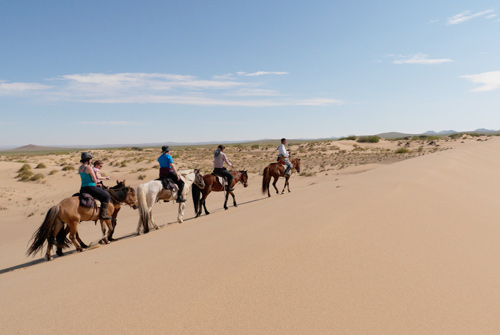

Meeting:
Ulaanbaatar
Airport:
Chinggis Khaan International Airport (UBN)
Train station:
Ulaanbaatar railway station
Transfer:
Ulaanbaatar
Distance:
15km
Pick-up/ drop-off for this trip is from Chinggis Khaan International Airport in Ulaanbaatar (UBN). You will be met for your arrival flight on Day 1 of the trip. Check-out from your hotel on the last day: 12:00pm.
|
Tack:
|
|
Mongolian Buryat Soldier Saddles
|
|
Horses:
|
|
Mongolian
|
|
Pace:
|
|
5-8 hours - many fast pace stretches
|
Walk |
Trot |
Canter |
|
|
Level:
|
|
 (3.5
to
4.5
out of 5) Intermediate+
(3.5
to
4.5
out of 5) Intermediate+
|
|
Age:
|
|
Min
12
|
Max
75
|
|
Weight:
|
|
Max
200 lbs
|
|
Riders:
|
|
Min
2 riders
|
Max
10 riders
|
|
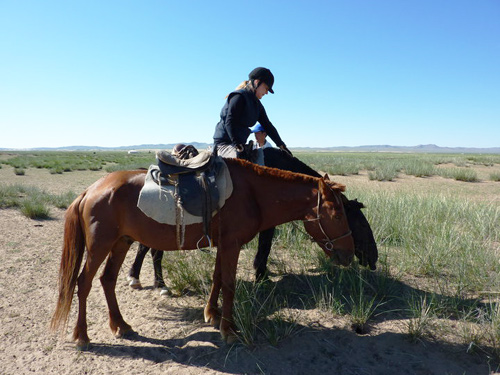
Mongolia is probably the most equestrian nation in the world. Not only is the Mongol heritage and lifestyle intimately connected with the horse, Mongolia is an exceptionally inviting place for keen horse riders. The absence of fences and the vast expanses of the steppes and forests are ideal for uninterrupted and scenic riding at its best!
On our trip, we emphasize the quality of human contacts and encounters with local people and respect for the horse and local equestrian traditions, from which many lessons can be learnt.
Riding Experience
You should be a competent rider, fit and capable of riding at all paces confidently. Varying terrain, in the saddle for several hours on most days.
Tack
We will provide you Russian saddles, which are more convenient for "western bottoms" than the Mongolian equivalent. We provide a saddle bag if needed.
Staff
A Mongolian English speaking guide will accompany the group at all times. A cook will follow with the camel cart caravan. In addition, the services of local herdsmen will be employed along with their animals. The horsemen follow a traditional lifestyle in the areas where we will be riding. If the group consists of 4 riders or more, we will also have a Mongolian doctor come along as part of the crew.
All our luggage will be loaded onto camel carts.
Passport and Visa Requirements:
Passports Passport valid for at least six months required by all nationals referred to in the chart. Visas Required by all nationals referred to in the chart above except: 1. nationals of the USA, if . more
Ulaanbaatar area
|
Month
|
Jan
|
Feb
|
Mar
|
Apr
|
May
|
Jun
|
Jul
|
Aug
|
Sep
|
Oct
|
Nov
|
Dec
|
|
Average High Temperature (°F)
|
4
|
14
|
30
|
48
|
62
|
72
|
76
|
72
|
61
|
45
|
23
|
7
|
|
Average Low Temperature (°F)
|
-20
|
-14
|
3
|
20
|
34
|
46
|
52
|
48
|
34
|
19
|
-1
|
-15
|
|
Average High Temperature (°C)
|
-16
|
-10
|
-1
|
9
|
17
|
22
|
24
|
22
|
16
|
7
|
-5
|
-14
|
|
Average Low Temperature (°C)
|
-29
|
-25
|
-16
|
-6
|
1
|
8
|
11
|
9
|
1
|
-7
|
-18
|
-26
|
|
Average Precipitation (days of rain)
|
0
|
0
|
0
|
0
|
1
|
3
|
4
|
3
|
1
|
0
|
0
|
0
|
Source: NOAA
Seasons
The mean elevation of Mongolia is about 1400 meters above sea level (5000 ft), which enhances the sharp continental climate. Mongolia has the highest atmospheric pressure in the world and the pronounced elevation as well as the distance from the moderating effects of the oceans, makes Ulaanbaatar the coldest capital city on Earth. This fact does not rule out extreme heat waves in the middle of the summer. In Mongolia the Central Asian desert zones meet with the Siberian taiga, hence, Mongolia is a transition zone with climatic extremes. Most of the year it is very cold, especially at night.
Winter
Precipitation is low and skies are usually clear during the wintertime.
Summer
Summers are very pleasant just as in the US and Europe. There is a short rainy season in July and August during which most of the annual rain will fall. Around 70 percent of all precipitation falls during this period. When raining it tend to be heavier and shorter, if extended it may cause floods locally. Occasional strong winds can come and go quickly. Even if this sounds like a lot of precipitation during the summertime it is just about the same as in Europe at the equivalent time. Mongolia is known as the land of the blue sky and throughout the year there are 278 sunny days and 9-23 cloudy days.
Spring and fall pass very quickly.
Dress is very informal but Mongolian sensibilities dictate a degree of modesty in the cut of the clothing worn. Hotel laundry services are available but you will need to bring two or three changes of clothing for the camping portion of the trip. This basic list will be adequate for the demands of our trips. While in Mongolia we will have weather in the 60's and 70's during the day, but nights will be cold. If you are passing through Beijing on the way to or from Mongolia, be aware that Beijing is hot and humid.
Useful items:
Small binoculars, travel alarm clock, earplugs, journal and pen, pocket knife (put in checked luggage, not allowed as carry‑on), lightweight snacks like granola bars, fruit bark, jerky, trail mix, nuts, tea bags that you can't start the day without, vitamins, water purification tablets, Mongolian phrasebook.
Our support structure is free from vehicles. All our provisions, camping equipment, luggage will be loaded on to yak carts. Even a ger (yurt) will be brought, and we will learn how to use it.
| This list is only a guideline for you |
|
|
| Travel documents and Voucher |
| Flight tickets |
| Passport |
| Visa (check with your consulate) |
|
|
| RIDING GEAR |
| Comfortable riding jeans or Jodhpurs |
| Riding boots (well broken in) or ankle-high riding shoes meant for endurance rides or ‘ride & ties’. These work especially well when worn with a pair of ‘half chaps’ (knee-high leather gaitors). They have a riding heel, but are comfortable enough to be used for your city and village footwear too. |
| Rubber overboots, especially if your riding boots have leather soles. |
| Riding gloves |
| Hat (with chin strip) for sun protection |
| Good rain gear: parka and rain pants or “duster” (no ponchos) |
|
|
| PERSONAL CLOTHING |
| Pile jacket or down vest |
| Wool sweater or wool shirt |
| Warm gloves |
| wool cap or other warm hat |
| Comfortable T-Shirts/Shirts |
| Jeans |
| Shorts |
| Underwear and socks |
| Long underwear for cold nights (polypropelene or capilene) |
| Women: Jogbra or other suitable sporty support |
| Pyjama |
| Bag for dirty clothes |
| Comfortable footwear for city and village walking (sturdy walking shoes or tennis shoes or lightweight hiking boots well broken in) |
| Swimsuit |
| Bandana or scarf |
| |
| For Camping trips: |
| Sturdy large duffel bag (30x15x14) |
| Sleeping bag (four‑season) |
| Ground mattress (supplied) |
| |
| ADDITIONAL THINGS TO BRING |
| Personal Toiletries |
| Insect protection |
| Personal medications |
| Sore cream (for the emergency) |
| small towel |
| Camera and enough extra films and batteries |
| Belt pack |
| Sun glasses with strap |
| Sun tan lotion and lip balm |
| Biodegradable campsuds |
| Minimum 1 liter water bottle (leather bota bags work great for riding) |
| Flashlight with change of batteries |
| Toilet paper |
| Extra baggage tags ("collecting" tags is popular with baggage handlers in Asia) |
| 5 large trash bags to line duffel and sleeping bag stuff sack |
| 6 small & medium zip loc bags for trash disposal |
| Luggage padlocks |
| 25 feet of nylon parachute cord (useful for tying raingear and saddle bags behind saddle) |
Sorry, no video is currently available for this tour.
*Important Notice: The following ratings have been submitted by guests and do not necessarily represent the views of Hidden Trails, its partners or employees.
Every care is taken to ensure accuracy but Hidden Trails is not liable for any errors or omissions.
..view other reports for different trips
���������������������������������������������������������������������������������������������������������������������������������������������������������������������������������������������������������������������������������������������������������������������������������������������������������������������������������������������������������������������������������������������������������������������������������������������������������������������������������������������������������������������������������������������������������������������������������������������������������������������������������������������������������������������������������������������������������������������������������������������������������������������������������������������������������������������������������������������������������������������������������������������������������������������������������������������������������������������������������������������������������������������������������������������������������������������������������������������������������������������������������������������������������������������������������������������������������������������������������������������������������������������������������������������������������������������������������������������������������������������������������������������������������������������������������������������������������������������������������������������������������������������������������������������������������������������������������������������������������������������������������������������������������������������������������������������������������������������������������������������������������������������������������������������������������������������������������������������������������������������������������������������������������������������������������������������������������������������������������������������������������������������������������������������������������������������������������������������������������������������������������������������������������������������������������������������������������������������������������������������������������������������������������������������������������������������������������������������������������������������������������������������������������������������������������������������������������������������������������������������������������������������������������������������������������������������������������������������������������������������������������������������������������������������������������������������������������������������������������������������������������������������������������������������������������������������������������������������������������������������������������������������������������������������������������������������������������������������������������������������������������������������������������������������������������������������������������������������������������������������������������������������������������������������������������������������������������������������������������������������������������������������������������������������������������������������������������������������������������������������������������������������������������������������������������������������������������������������������������������������������������������������������������������������������������������������������������������������������������������������������������������������������������������������������������������������������������������������������������������������������������������������������������������������������������������������������������������������������������������������������������������������������������������������������������������������������������������������������������������������������������������������������������������������������������������������������������������������������������������������������������������������������������������������������������������������������������������������������������������������������������������������������������������������������������������������������������������������������������������������������������������������������������������������������������������������������������������������������������������������������������������������������������������������������������������������������������������������������������������������������������������������������������������������������������������������������������������������������������������������������������������������������������������������������������������������������������������������������������������������������������������������������������������������������������������������������������������������������������������������������������������������������������������������������������������������������������������������������������������������������������������������������������������������������������������������������������������������������������������������������������������������������������������������������������������������������������������������������������������������������������������������������������������������������������������������������������������������������������������������������������������������������������������������������������������������������������������������������������������������������������������������������������������������������������������������������������������������������������������������������������������������������������������������������������������������������������������������������������������������������������������������������������������������������������������������������������������������������������������������������������������������������������������������������������������������������������������������������������������������������������������������������������������������������������������������������������������������������������������������������������������������������������������������������������������������������������������������������������������������������������������������������������������������������������������������������������������������������������������������������������������������������������������������������������������������������������������������������������������������������������������������������������������������������������������������������������������������������������������������������������������������������������������������������������������������������������������������������������������������������������������������������������������������������������������������������������������������������������������������������������������������������������������������������������������������������������������������������������������������������������������������������������������������������������������������������������������������������������������������������������������������������������������������������������������������������������������������������������������������������������������������������������������������������������������������������������������������������������������������������������������������������������������������������������������������������������������������������������������������������������������������������������������������������������������������������������������������������������������������������������������������������������������������������������������������������������������������������������������������������������������������������������������������������������������������������������������������������������������������������������������������������������������������������������������������������������������������������������������������������������������������������������������������������������������������������������������������������������������������������������������������������������������������������������������������������������������������������������������������������������������������������������������������������������������������������������������������������������������������������������������������������������������������������������������������������������������������������������������������������������������������������������������������������������������������������������������������������������������������������������������������������������������������������������������������������������������������������������������������������������������������������������������������������������������������������������������������������������������������������������������������������������������������������������������������������������������������������������������������������������������������������������������������������������������������������������������������������������������������������������������������������������������������������������������������������������������������������������������������������������������������������������������������������������������������������������������������������������������������������������������������������������������������������������������������������������������������������������������������������������������������������������������������������������������������������������������������������������������������������������������������������������������������������������������������������������������������������������������������������������������������������������������������������������������������������������������������������������������������������������������������������������������������������������������������������������������������������������������������������������������������������������������������������������������������������������������������������������������������������������������������������������������������������������������������������������������������������������������������������������������������������������������������������������������������������������������������������������������������������������������������������������������������������������������������������������������������������������������������������������������������������������������������������������������������������������������������������������������������������������������������������������������������������������������������������������������������������������������������������������������������������������������������������������������������������������������������������������������������������������������������������������������������������������������������������������������������������������������������������������������������������������������������������������������������������������������������������������������������������������������������������������������������������������������������������������������������������������������������������������������������������������������������������������������������������������������������������������������������������������������������������������������������������������������������������������������������������������������������������������������������������������������������������������������������������������������������������������������������������������������������������������������������������������������������������������������������������������������������������������������������������������������������������������������������������������������������������������������������������������������������������������������������������������������������������������������������������������������������������������������������������������������������������������������������������������������������������������������������������������������������������������������������������������������������������������������������������������������������������������������������������������������������������������������������������������������������������������������������������������������������������������������������������������������������������������������������������������������������������������������������������������������������������������������������������������������������������������������������������������������������������������������������������������������������������������������������������������������������������������������������������������������������������������������������������������������������������������������������������������������������������������������������������������������������������������������������������������������������������������������������������������������������������������������������������������������������������������������������������������������������������������������������������������������
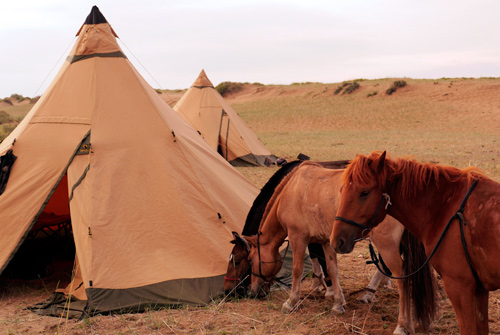
Accommodations
This is a progressive ride, so you will be staying in different locations during the trip.
Description
You will be staying in a hotel for 2 nights, a low-impact ger camp for 2 nights, and tent tipis for 7 nights (changing location every 2 nights), making a total of 5 different locations. All accommodations are based on double occupancy.
Accommodation Itinerary - subject to changes based on availability
Night 1: Bayangol Hotel in Ulaanbaatar
Night 2-8: Tent Tipis
Night 9 and 10: Low-impact ger camp in Arburd Sands
Night 10: Bayangol Hotel in Ulaanbaatar
Bayangol Hotel in Ulaanbaatar
Ideally located in the city center, this hotel offers elegant and comfortable ensuite bedrooms. Each room is equipped with air conditioning, a TV, free Wi-Fi access and tea and coffee making facilities. Laundry is available for an additional cost.
Tent Tipis
Temporary camps in spacious tent tipis, with foldable bed-cots. We take along a Mongolian ger (yurt ) to serve as our mobile restaurant, as well as showers and compost toilets housed in traditional Mongolian marquee style tents.
Bring your own sleeping bag. During cold spells early and late in season, there is a slight chance of night temperatures below zero centigrade. Frost is unlikely, but can happen between June 15th to September 1st. A four season sleeping bag is definitely necessary early and late in the season. If you feel cold easy, or your body is small, you should take some care in the selection of a sleeping bag. The idea of a sleeping bag is that your own body heat will maintain and keep the warmth inside the bag. It means that sleeping without clothes is better than having warm clothes on. And small people should not sleep in a very large sleeping bag as they cannot heat the space with their own body temperatures. If you have never slept under the stars: Don’t worry!
You will find it a real pleasure!
Toilets tents with a drop toilet with wooden seat and separate shower tents are on site. We ask our clients to bring bio-degradable toiletries only.
Low-impact ger camp in Arburd Sands
This is a permanent camp with 16 gers (capacity of 34 people). The gers are each equipped with cot beds (including full linen), chairs and a table, and a wood burning stove. Restaurant ger. Toilets tents with a drop toilet with wooden seat and separate shower tents are on site. We ask our clients to bring bio-degradable toiletries only.
Room Occupancy
Triple occupancy is possible.
Single riders listed as 'willing to share' do not have to pay the single supplement cost if we are unable to find another rider to share.
 Meals
Meals
All meals except lunch in Ulaanbaatar are included in the trip.
Our cook will prepare the meals. We pride ourselves in having excellent cooks adept at both western and Mongolian cooking on our trips. We can usually buy fresh milk and yogurt from local herdsmen. Traditional Mongols mostly eat meat and milk products. Mongolians who live in the city have adopted Russian and Western food habits. Although, they still like the traditional foods of the countryside, and frequently also eat these. The cuisine features lamb and mutton, the Kazakhs in western Mongolia prefer goat. We usually boil water all the time, and your water bottle may be filled in the evening. Alcohol is not allowed on this trip.
Dietary Restrictions
We can cater for vegetarians. Please make sure to advice us in advance of any dietary requirements that you may have.
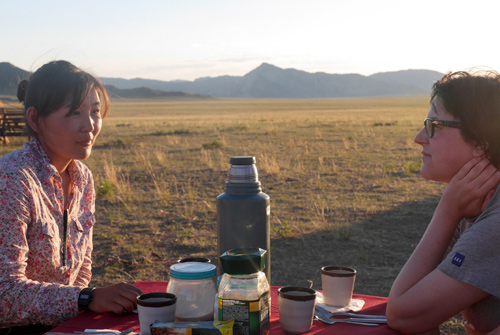
This trip
can accommodate special dietary requests.
|
Tack:
|
|
Mongolian Buryat Soldier Saddles
|
|
Horses:
|
|
Mongolian
|
|
Pace:
|
|
5-8 hours - many fast pace stretches
|
Walk |
Trot |
Canter |
|
|
Level:
|
|
 (3.5
to
4.5
out of 5) Intermediate+
(3.5
to
4.5
out of 5) Intermediate+
|
|
Age:
|
|
Min
12
|
Max
75
|
|
Weight:
|
|
Max
200 lbs
|
|
Riders:
|
|
Min
2 riders
|
Max
10 riders
|
|

Mongolia is probably the most equestrian nation in the world. Not only is the Mongol heritage and lifestyle intimately connected with the horse, Mongolia is an exceptionally inviting place for keen horse riders. The absence of fences and the vast expanses of the steppes and forests are ideal for uninterrupted and scenic riding at its best!
On our trip, we emphasize the quality of human contacts and encounters with local people and respect for the horse and local equestrian traditions, from which many lessons can be learnt.
Riding Experience
You should be a competent rider, fit and capable of riding at all paces confidently. Varying terrain, in the saddle for several hours on most days.
Tack
We will provide you Russian saddles, which are more convenient for "western bottoms" than the Mongolian equivalent. We provide a saddle bag if needed.
Staff
A Mongolian English speaking guide will accompany the group at all times. A cook will follow with the camel cart caravan. In addition, the services of local herdsmen will be employed along with their animals. The horsemen follow a traditional lifestyle in the areas where we will be riding. If the group consists of 4 riders or more, we will also have a Mongolian doctor come along as part of the crew.
All our luggage will be loaded onto camel carts.
Passports
Passport valid for at least six months required by all nationals referred to in the chart.
Visas
Required by all nationals referred to in the chart above except:
1. nationals of the USA, if entering the country as a tourist, for stays of up to 90 days.
Visa Note
(a) All foreign nationals staying in Mongolia for longer than 30 days are required to register with the police within 10 days of arrival. (b) Nationals entering Mongolia for stays up to 30 days should apply for an Entry and Exit visa; for stays over 90 days nationals should apply for an Entry visa. (c) Nationals transiting via trains can apply for a single-, double- or multiple-entry Transit visa.
Types of Visa and Cost
Entry and Exit visa: £40 (single-entry, 30 days); £55 (double-entry, 30 days per visit). Entry visa: £35 (single-entry, 90 days). Transit visa: £35 (single-entry); £40 (double-entry); £45 (multiple-entry).
Validity
Visas are valid for three months from date of issue.
Applications to:
Consulate (or consular section at embassy); see Contact Addresses. If travelling on an organised tour, visas can be obtained through tourism companies or travel agencies. A group visa in the name of the tour leader is valid for all tourists on the list attached, provided relevant details (nationality, sex, date of birth, passport numbers, and dates of issue and expiry) are given at the time of application.
Working Days Required
Two to five. An express service is available which costs an additional £20.
| Passport Required? |
| British |
Yes |
| Australian |
Yes |
| Canadian |
Yes |
| USA |
Yes |
| Other EU |
Yes |
| Visa Required? |
| British |
Yes |
| Australian |
Yes |
| Canadian |
Yes |
| USA |
1 |
| Other EU |
Yes |
| Return Ticket Required? |
| British |
No |
| Australian |
No |
| Canadian |
No |
| USA |
No |
| Other EU |
No |
This information is not being updated on a regular basis. Hidden Trails does not
take any responsibility for the accuracy of the above information. Please, consult
the embassy or consulate for updated info.
|

|
|
|
Gobi Steppe Ride
Tour Code:
IT-MNRT10
12 days /
11 nights
Dates :
June to Aug
Trip Rating :

Difficulty :

Riding Level Explained | A | Beginner
 | Beginner A rider who has limited experience, is unable to post the trot and does not canter. | | B | Novice
 | Novice A rider who is capable of mounting and dismounting unassisted, capable of
applying basic aids, comfortable and in control at the walk, moderate length posting
trots, and short canters. | | C | Intermediate
 | Intermediate A rider who has a firm seat, is confident and in control at all paces
(including posting trots, two point canters and gallops), but does not ride regularly. |
| D | Strong Intermediate
 | Strong Intermediate An intermediate rider who is currently riding regularly and is comfortable in the saddle for at least 6 hours per day. | | E | Advanced
 | All of the above, plus an independent seat, soft hands, and capable of handlinga spirited horse in open country. |

|